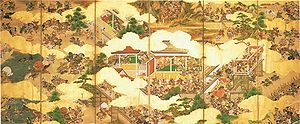| Genpei War (Jishō–Juei War) | ||||||||
|---|---|---|---|---|---|---|---|---|
| Part of Minamoto–Taira clan disputes of late Heian period | ||||||||
 Scene of the Genpei War | ||||||||
| ||||||||
| Belligerents | ||||||||
|
|
|
| ||||||
| Commanders and leaders | ||||||||
The Genpei War (源平合戦, Genpei Kassen, Genpei-Gassen, 1180–1185) was a national civil war[1] between the Taira and Minamoto clans during the late Heian period of Japan. It resulted in the downfall of the Taira and the establishment of the Kamakura shogunate under Minamoto no Yoritomo, who appointed himself as Shōgun in 1192, governing Japan as a military dictator from the eastern city of Kamakura.
It followed a coup d'état by the Taira in 1179 with the removal of rivals from all government posts, and subsequently banishing them, and a call to arms against the Taira, led by the Minamoto in 1180. The ensuing Battle of Uji took place just outside Kyoto, starting a five-year-long war, concluding with a decisive Minamoto victory in the naval Battle of Dan-no-ura. However, it has been pointed out that the Battle of Ōshū in 1189 was the last battle during this period of civil war, as it completed Yoritomo's nationwide domination through the annexation of Northeast Japan.
The name "Genpei" (sometimes romanized as Gempei) comes from alternate readings of the kanji "Minamoto" (源 Gen) and "Taira" (平 Hei, pronounced as the second element in some compounds as -pei). The conflict is also known in Japanese as the Jishō–Juei War (治承・寿永の乱, Jishō–Juei no Ran),[2][3] after the two Imperial eras between which it took place. The term Genpei Kassen is sometimes used in Japan, but it has been argued that it is not appropriate to use the term "Genpei" for this war.
- ^ "…the Gempei conflict was a national civil war" Warrior Rule in Japan, page 2. Cambridge University Press.
- ^ In the name "Jishō–Juei War", the noun "Jishō" refers to the nengō (Japanese era name) after "Angen" and before "Yōwa." In other words, the Jishō–Juei War occurred during Jishō, which was a time period spanning the years from 1177 through 1181.
- ^ In the name "Jishō–Juei War", the noun "Juei" refers to the nengō (Japanese era name) after "Yōwa" and before "Genryaku." In other words, the Jishō–Juei War occurred during Juei, which was a time period spanning the years from 1182 through 1184.